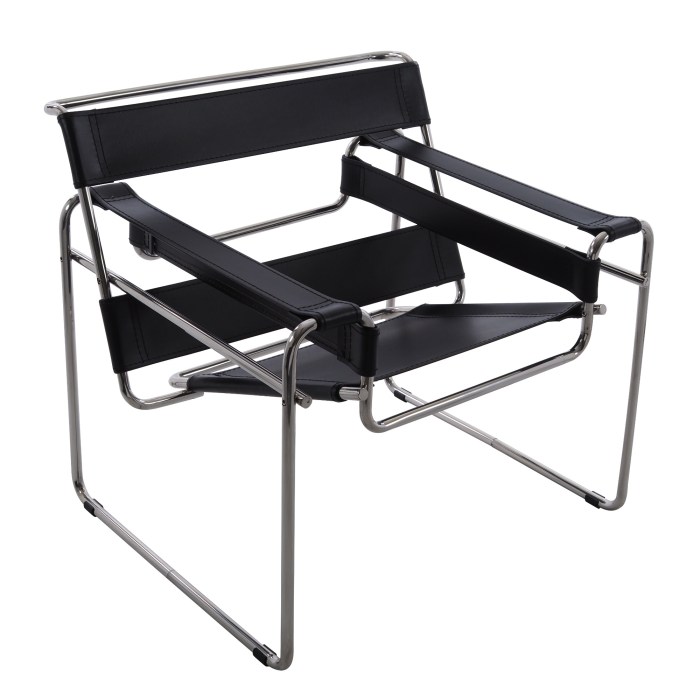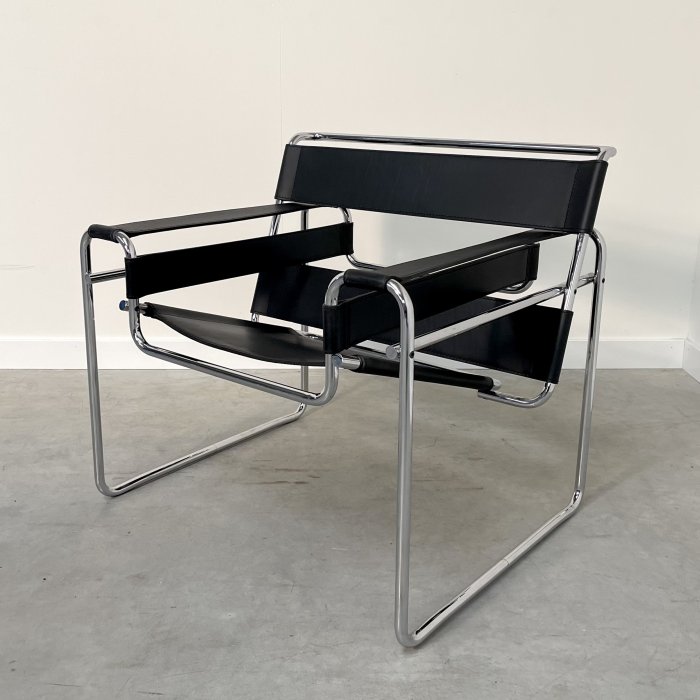Exploring the Fascinating World of the Wassily Chair
As the iconic Wassily chair takes center stage, this opening passage beckons readers into a world crafted with expert knowledge. Prepare to delve into the rich history, unique features, and cultural impact of this design masterpiece.
Get ready to explore the design aesthetics, construction process, variations, influences, and cultural significance that make the Wassily chair a timeless symbol of modernist design.
Introduction

The Wassily chair, also known as the Model B3 chair, is a classic piece of furniture that has stood the test of time with its innovative design and timeless appeal. Designed by Marcel Breuer in 1925, this iconic chair has become a symbol of modernist design and continues to be a popular choice in interior decor.
Brief History of the Wassily Chair
The Wassily chair was inspired by the frame of a bicycle and was originally created for painter Wassily Kandinsky, hence its name. Marcel Breuer, a Hungarian-born architect and designer, was a key figure in the Bauhaus movement and is credited with designing the Wassily chair while he was a part of the Bauhaus school in Germany.
Designer: Marcel Breuer
Marcel Breuer was known for his innovative use of materials and his modernist approach to design. He was influenced by the De Stijl and Constructivist movements, which can be seen in the geometric shapes and minimalist aesthetic of the Wassily chair.
Breuer's design philosophy focused on combining form and function to create visually striking yet practical pieces of furniture.
Unique Features of the Wassily Chair
- The Wassily chair is made of tubular steel, which was a groundbreaking material choice at the time of its design.
- Its cantilevered frame gives the chair a light and airy appearance, while still providing sturdy support.
- The chair's simple and elegant design allows it to seamlessly blend into various interior styles, from modern to eclectic.
- The use of leather for the seat and backrest adds a touch of luxury and comfort to the chair, making it both stylish and functional.
Design and Materials
The Wassily chair, designed by Marcel Breuer in 1925, is a quintessential piece of modernist furniture known for its innovative design and sleek aesthetics. The chair features a unique frame made of tubular steel, which was a groundbreaking material choice at the time.
Design Aesthetics
The Wassily chair is characterized by its minimalistic and geometric design, with a cantilevered frame that creates a sense of lightness and elegance. The use of tubular steel gives the chair a distinct industrial look, while the leather or canvas seat and backrest provide comfort and contrast to the metal structure.
Materials Used
- Tubular Steel: The frame of the Wassily chair is made of seamless tubular steel, a material that was traditionally used in bicycle frames. This choice of material allowed for a new approach to furniture design, combining strength and flexibility in a visually striking way.
- Leather or Canvas: The seat and backrest of the chair are often made of leather or canvas, adding a touch of luxury and comfort to the sleek metal frame. The use of these materials also reflects the Bauhaus principles of craftsmanship and functionality.
Significance in Modernist Design
The Wassily chair is considered a pioneering example of modernist design, embodying the principles of form following function and the use of innovative materials. Its revolutionary approach to furniture construction paved the way for a new era of design, influencing countless contemporary pieces and setting a standard for modernist aesthetics.
Construction Process
The construction process of the Wassily chair involves intricate steps that require skilled craftsmanship to achieve the iconic design. From bending the tubular steel to assembling the leather straps, every detail is crucial in creating a piece that is both functional and visually striking.
Bending and Shaping Tubular Steel
One of the key elements of the Wassily chair is the use of bent tubular steel for the frame. Craftsmen carefully shape the steel tubes using specialized equipment to achieve the distinctive curves and angles that define the chair's silhouette.
Assembling Leather Straps
The leather straps of the Wassily chair are meticulously woven through the steel frame to create the seat and backrest. This process requires precision and attention to detail to ensure that the straps are securely attached and provide the necessary support for the user.
Finishing and Quality Control
Once the frame and straps are assembled, the chair undergoes a final inspection to ensure that every component meets the high standards set by the original design. Quality craftsmanship is essential in creating a Wassily chair that not only looks beautiful but also functions seamlessly for years to come.
Variations and Influences
The Wassily chair, originally designed by Marcel Breuer, has undergone various modifications and adaptations over time, leading to different variations of the iconic design. Additionally, the chair's innovative use of materials and structure has influenced numerous other furniture designs in the modern era.
Evolution of the Wassily Chair
- Initial design by Marcel Breuer featuring tubular steel frame and canvas or leather seat and back
- Later variations introduced changes in materials, colors, and proportions while maintaining the signature Bauhaus style
- Contemporary versions include updates in technology and manufacturing techniques for enhanced comfort and durability
Influences on Furniture Design
- The Wassily chair's innovative use of tubular steel and minimalist aesthetic has inspired a wide range of modern furniture designs
- Designers have drawn inspiration from the chair's clean lines and geometric forms to create new pieces that reflect the Bauhaus principles
- Its influence can be seen in various chairs, tables, and other furniture items that prioritize both form and function
Cultural Impact
The Wassily chair has left a lasting cultural impact on the world of design since its creation. Its innovative use of materials and unique design have made it an iconic piece that transcends borders and time.
Perception in Different Regions
- In Europe, the Wassily chair is often seen as a symbol of modernism and the Bauhaus movement, reflecting a break from traditional design principles.
- In the United States, the chair is celebrated for its sleek and minimalist aesthetic, becoming a staple in contemporary interior design.
- In Asia, the Wassily chair is recognized for its blend of form and function, appealing to a wide range of design enthusiasts.
Symbolism in the Design World
The Wassily chair symbolizes a departure from ornate and heavy furniture designs of the past, embracing simplicity, functionality, and industrial materials. Its innovative use of tubular steel and leather challenged traditional notions of what furniture could be, inspiring generations of designers to push boundaries and explore new possibilities in design.
Last Point

In conclusion, the Wassily chair stands as a testament to innovative design, quality craftsmanship, and cultural influence. Delve deeper into the legacy of this iconic piece and discover the enduring impact it has had on the world of furniture design.
Question Bank
How did the Wassily chair get its name?
The chair was named after the famous Bauhaus designer Wassily Kandinsky, who was a contemporary of Marcel Breuer.
What materials are commonly used in constructing the Wassily chair?
The chair is typically made of chrome-plated steel for the frame and leather for the seat and back.
What is the symbolism associated with the Wassily chair?
The chair is often seen as a symbol of modernist design and the innovative spirit of the early 20th century.




